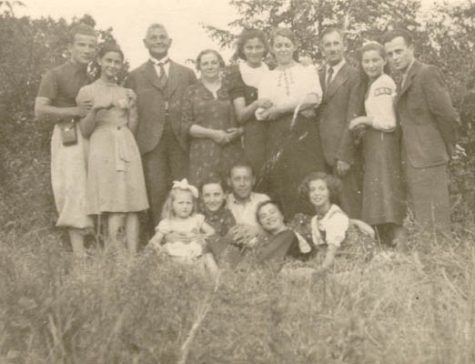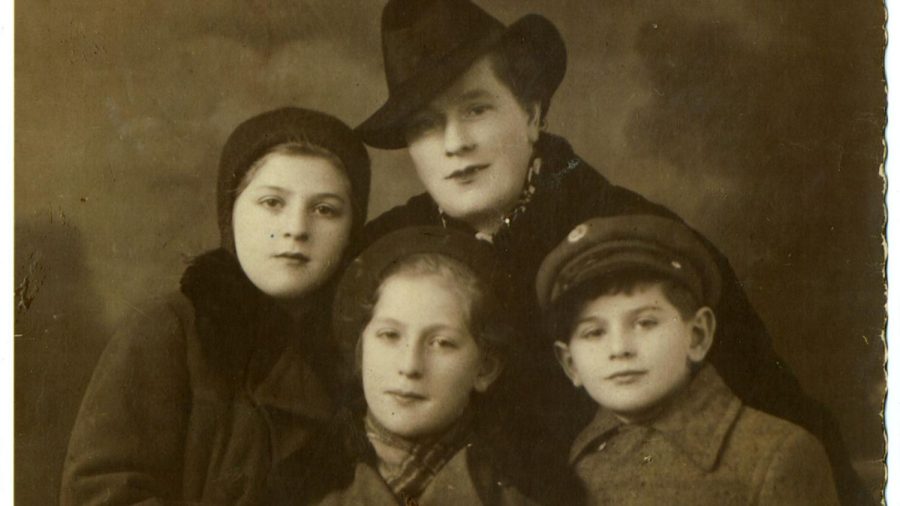How to view rare film depicting Jewish life in Poland before the Holocaust
Studio portrait of Sara Fogelman and her three children in prewar Radomsko, Poland, shortly before the war.
Pictured are Pola (left), Genia (bottom), Abraham Joseph (far right), and their mother Sara (top.) United States Holocaust Memorial Museum, courtesy of Pola Spitzer
Published April 11, 2023
In January, construction workers renovating an old tenement house in the city of Lodz, Poland made an unusual discovery. They unearthed hundreds of Jewish artifacts that were hidden before the Nazis occupied the city. The cache included menorahs, kiddush cups and other items of everyday life, all buried next to a building that was near the ghetto that would imprison thousands.
The discovery shined an important light on what life was like in Poland before the Nazis invaded.
Prior to World War I, Jewish populations were concentrated in Eastern Europe, with a large percentage living in small villages called shtetls. These poverty-stricken shtetls were vibrant centers of Jewish spirituality. An Industrial Revolution emerged in Poland following WWI that created new opportunities, and there was a mass exodus from shtetls to urbanized cities.
Before the war, more than 250,000 Jews lived in Lodz making it one of the largest Jewish communities in all of Europe. Only 10,000 would survive.
Jewish life in Poland before the Holocaust
In commemoration of Yom HaShoah, Holocaust Remembrance Day on April 18, Mirowitz Center is welcoming Sheldon Enger, a local Jewish educator who will present a special look at life in Poland before the start of the Holocaust.
“Since the end of the war, we have tasked ourselves to never forget what happened during the Holocaust. Invariably we remember the concentration camps, the death marches, and the open pits filled with bodies. All horrific images,” said Enger. “But now it’s time to remember the beauty of the lives those people lived.”

To do this, Enger will show a rare documentary film presenting Jewish communities in Poland, shortly before their annihilation by Nazi Germany.
“The film shows the life of the Jewish population in five different cities,” said Enger. “The film was shot just months prior to the German invasion.
‘Six Cities: The Last Glimpse of Jewish Life in Poland’
Some months before the outbreak of World War II, two famous Jewish-Polish film producers, the brothers Shaul and Yitzhak Goskind from Warsaw, produced six short films about the most important Jewish communities in six big Polish cities: Warsaw, Lvov (Lemberg), Cracow (Krakow), Vilna (Vilnius), Bialystok and Lodz.
The films show the cultural, religious, economic and social life of the Jews and describe their integration into Polish society. The brothers Goskind tried to present a characteristic picture of Jewish life in the biggest Jewish communities in Poland and depict the variety of life patterns within their existence in Poland.
By pure chance, five of those films – all but the film on Lodz – survived the war and were discovered in New York around 1943, a time when most of the Jews appearing in the films had already been murdered.
“The films allow us to remember not just the horror of their deaths, but the beauty of the lives and the culture they created,” said Enger.
Enger, who began teaching and lecturing on Jewish history after retiring from a career as a management consultant, discovered the films by sheer luck back in 2012.
“I was teaching a class on the Exodus at Washington University. One of my students was a 93-year-old gentleman, who happened to have worked with the photographers of the documentaries,” remembered Enger. “As a result, he was given the original videos, and with the help of Hebrew University in Israel, the five surviving films were made into one. He gave me a copy on DVD.”
How to see ‘Six Cities’
Enger will screen the documentary as part of his lecture “Fighting Bigotry & Hatred: Jewish Life in Poland Before the Holocaust” on Tuesday, April 18 from 10 to 11 a.m. at Mirowitz Center. It is co-sponsored by ADL Heartland and the St. Louis Kaplan Feldman Holocaust Museum, along with FEL (Friends Enjoying Life), the Mirowitz Center men’s organization.
The event is free, but registration is required.
| RELATED: “Talking Beatles” comes from lifelong love for the band and brushes with Beatles royalty
















